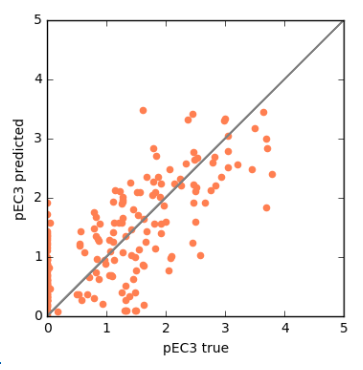Multiple Regression Summary of defined approach
The method uses a multiple regression model to predict LLNA pEC3 value based on the results of in vitro assays and physico-chemical properties of the compound. The input data, which gave the best regression model, consists of parameters from the KeratinoSens (EC1.5, IC50), peptide reactivity assay (Kmax) and the compound’s vapour pressure (predicted by TIMES). The global regression model is based on the dataset of 244 compounds [1] and gives R-squared of 0.60. Accuracy of the regression model is depicted on the image below, where the predicted pEC3 values for 244 compounds are plotted against their true pEC3 values. The straight diagonal line represents the results of a perfect model.

Advantages of the Regression approach include:
- Flexibility: regression model can be built on various input parameters using more or fewer parameters.
- Allows for adaptation for assessment of compounds that cannot be grouped in any known domains.
- Provides a predicted LLNA pEC3 value which can be used directly in quantitative assessments or discretized for categorical classification.
Experimental values used in SaferSkin™
| Input parameters | Provided by user | Calculated by application |
|---|---|---|
| Molecular descriptors | ||
| Vapour pressure | ||
| Experimental values | ||
| Cor1-C420 assay: Kmax | ||
| KeratinoSens™ assay: KEC1.5, IC50 | ||
(1) A. Natsch, R. Emter, H. Gfeller, T. Haupt and G. Ellis,Toxicol. Sci. 2015